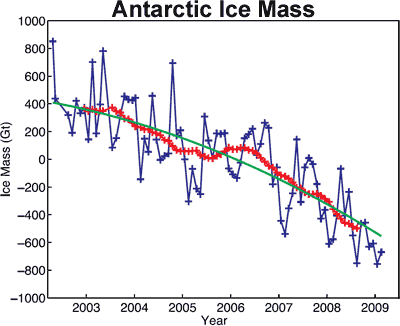Ice loss On Antarctica
 Press release by the Potsdam Institute for Climate Impact Research:
Press release by the Potsdam Institute for Climate Impact Research:
12/13/2012
More ice loss through snowfall on Antarctica
Stronger snowfall increases future ice discharge from Antarctica. Global warming leads to more precipitation as warmer air holds more moisture – hence earlier research suggested the Antarctic ice sheet might grow under climate change. Now a study published in Nature shows that a lot of the ice gain due to increased snowfall is countered by an acceleration of ice-flow to the ocean. Thus Antarctica’s contribution to global sea-level rise is probably greater than hitherto estimated, the team of authors from the Potsdam Institute for Climate Impact Research (PIK) concludes.
“Between 30 and 65 percent of the ice gain due to enhanced snowfall in Antarctica is countervailed by enhanced ice loss along the coastline,” says lead-author Ricarda Winkelmann. For the first time, an ensemble of ice-physics simulations shows that future ice discharge is increased up to three times because of additional precipitation in Antarctica under global warming. “The effect exceeds that of surface warming as well as that of basal ice-shelf melting,” Winkelmann says.
Snow piling up exerts pressure on the ice, thus it flows faster to the coast
During the last decade, the Antarctic ice-sheet has lost volume at a rate comparable to that of Greenland. “The one certainty we have about Antarctica under global warming is that snowfall will increase,” Winkelmann explains. “Since surface melt might remain comparably small even under strong global warming, because Antarctica will still be a pretty chilly place, the big question is: How much more mass within the ice sheet will slowly but inexorably flow off Antarctica and contribute to sea-level rise, which is one of the major impacts of climate change.”
Since snowfall on the ice masses of Antarctica takes water out of the global water cycle, the continent’s net contribution to sea-level rise could be negative during the next 100 years – this is what a number of global and regional models suggest. The new findings indicate that this effect to a large extent is offset by changes in the ice-flow dynamics. Snow piling up on the ice is heavy and hence exerts pressure – the higher the ice the more pressure. Because additional snowfall elevates the grounded ice-sheet but less so the floating ice shelves, it flows more rapidly towards the coast of Antarctica where it eventually breaks off into icebergs and elevates sea level.
“Sea-level is rising – that is a fact”
A number of processes are relevant for ice-loss in Antarctica, most notably to sub-shelf melting caused by warming of the surrounding ocean water. These phenomena explain the already observed contribution to sea-level rise.
“We now know that snowfall in Antarctica will not save us from sea-level rise,” says second author Anders Levermann, research domain co-chair at PIK and a lead author of the sea-level change chapter of the upcoming IPCC’s 5th assessment report. “Sea level is rising – that is a fact. Now we need to understand how quickly we have to adapt our coastal infrastructure; and that depends on how much CO2 we keep emitting into the atmosphere,” Levermann concludes.
Article: Winkelmann, R., Levermann, A., Martin, M.A., Frieler, K. (2012): Increased future ice discharge from Antarctica owing to higher snowfall. Nature [doi:10.1038/nature11616]
Weblink to the article here.
For further information please contact:
PIK press office
Phone: +49 331 288 25 07
E-Mail: press@pik-potsdam.de



 “Interglacial Narrows (Poems 1915-2021)” Contra Mundum Press
“Interglacial Narrows (Poems 1915-2021)” Contra Mundum Press “Always the Many, Never the One: Conversations In-between, with Florent Toniello” Contra Mundum Press
“Always the Many, Never the One: Conversations In-between, with Florent Toniello” Contra Mundum Press “Conversations in the Pyrenees”
“Conversations in the Pyrenees” “A Voice Full of Cities: The Collected Essays of Robert Kelly.” Edited by Pierre Joris & Peter Cockelbergh
“A Voice Full of Cities: The Collected Essays of Robert Kelly.” Edited by Pierre Joris & Peter Cockelbergh “An American Suite” (Poems) —Inpatient Press
“An American Suite” (Poems) —Inpatient Press “Arabia (not so) Deserta” : Essays on Maghrebi & Mashreqi Writing & Culture
“Arabia (not so) Deserta” : Essays on Maghrebi & Mashreqi Writing & Culture “Barzakh” (Poems 2000-2012)
“Barzakh” (Poems 2000-2012) “Fox-trails, -tales & -trots”
“Fox-trails, -tales & -trots” “The Agony of I.B.” — A play. Editions PHI & TNL 2016
“The Agony of I.B.” — A play. Editions PHI & TNL 2016 “The Book of U / Le livre des cormorans”
“The Book of U / Le livre des cormorans” “Memory Rose Into Threshold Speech: The Collected Earlier Poetry of Paul Celan”
“Memory Rose Into Threshold Speech: The Collected Earlier Poetry of Paul Celan” “Paul Celan, Microliths They Are, Little Stones”
“Paul Celan, Microliths They Are, Little Stones” “Paul Celan: Breathturn into Timestead-The Collected Later Poetry.” Translated & with commentary by Pierre Joris. Farrar, Straus & Giroux
“Paul Celan: Breathturn into Timestead-The Collected Later Poetry.” Translated & with commentary by Pierre Joris. Farrar, Straus & Giroux
Rather than quote the myriad of sources I usually cite in order to mount a reasonable challenge to poor old one note Potsdam, this time I will merely point out that “might”, “probably,” and “models” fall woefully short of bad science, even for them. Snow is bad, it makes us warm. Rain is bad, it makes us warmer. Sun is bad, it makes us hot. All colds lead to warming somehow. What else is left? They are a one stop solution. Everything is to blame. Can they really raise money with this philosophy or is the government their main supporter? Don’t tell me.
I have a couple of suggestions for dealing with the potential rising of sea levels and the annual damage caused by flooding and storms. Yes, we have flooding and storms every year in all the same places! One is to stop building population centres so close to sea level unless such structures are appropriately raised and fortified. Those that choose to live in such high risk areas should be responsible for insuring said buildings thus saving the taxpayers the yearly cost of clean up and repair. The second involves population. World population has risen from around 370 million in 1350 to over 7 billion today. That’s a lot of CO2 not to mention all their pets, livestock and assorted wild animals. What we need is a really big World War of catastrophic proportions to massively thin the herd. It’s a big herd and will require much, much thinning. I suggest that all old people, retirees like me, should form the front lines. A side benefit would be the enormous savings in social programs and health care thus ensuring the financial stability of any countries that may be left standing.
As to the climate, maybe after we have solved the CO2 issue (see World War) those fortunate enough to be alive may come to appreciate the work of Henrik Svensmark, a professor of physics at the Center for Sun-Climate Research at the Danish Space Research Institute. His research clearly demonstrates that the Sun and cosmic rays, not man, drives the current climate on Earth.
So they’ll have a clean start in a brand new , less populated world. And there will be plenty of work rebuilding the place. It will take centuries to screw it up again. Just a thought. Let Potsdam complain about that.